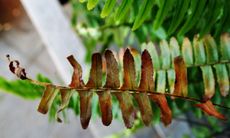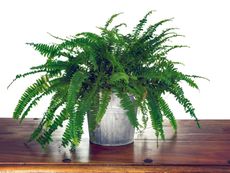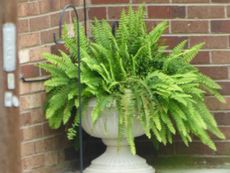Boston Fern Diseases: Caring For Unhealthy Boston Ferns


Boston ferns (Nephrolepis exaltata ‘Bostoniensis') are old-fashioned ferns with beautiful arching fronds. They require adequate sunlight, water and nutrients to thrive, and good cultural practices help keep your fern healthy. If your fern doesn’t get the best care – or even if it does – it may be attacked by Boston fern diseases. Read on to learn more about diseases of Boston fern plants.
Common Boston Fern Problems
If you fail to water your potted fern appropriately, over or under irrigation can lead to unhealthy Boston ferns. Most fern instructions advise you to keep the soil constantly moist. But this is not the same as allowing the soil to be wet or the plant to become water-logged. To avoid issues with Boston ferns, water the plant thoroughly when the top of the soil is dry. Keep watering until it leaks from the drain holes in the bottom of the pot. Do not water again until the soil surface is dry. Failure to water sufficiently can lead to graying, one of the most common Boston fern problems. Graying is often the result of drought conditions. You’ll know if your plant has this condition when the leaves turn gray and the plant may seem to stop growing. Increasing irrigation should resolve this. Although many gardeners consider tropical ferns low-light plants, Boston ferns need adequate light. If they do not get a medium amount of light – at least two hours of indirect light all year round – their fronds become long and pendulous. This is termed weak frond and is resolved by increasing light.
Boston Fern Diseases
If the fronds of your Boston fern turn gray and you’ve been watering properly, a disease to consider next is Pythium root rot. The fronds can also wilt or grow stunted. To confirm root rot, look at the roots of your unhealthy Boston ferns. If they are brown and stunted, it is likely root rot. The best way to prevent a Boston fern from getting root rot is to buy disease-free plants and pathogen free potting soil. You can also check in your garden store for chemicals that control this disease in Boston ferns. These tips are also appropriate for preventing and treating other Boston fern diseases such as Rhizoctonia aerial blight. In blight, dark lesions develop rapidly on the foliage and roots. Unchecked, the entire plant is eventually covered with the pathogen’s brown web-like mycelium. If you opt to use chemicals to treat this disease, treat the soil as well.
Gardening tips, videos, info and more delivered right to your inbox!
Sign up for the Gardening Know How newsletter today and receive a free download of our most popular eBook "How to Grow Delicious Tomatoes."

Teo Spengler has been gardening for 30 years. She is a docent at the San Francisco Botanical Garden. Her passion is trees, 250 of which she has planted on her land in France.
-
 How To Get Rid Of Mosquitoes In The Garden: 9 Natural Ways To Make Them Buzz Off!
How To Get Rid Of Mosquitoes In The Garden: 9 Natural Ways To Make Them Buzz Off!How to get rid of mosquitoes is on the minds of people in the summer in almost every region of the world. Learn how to repel the pests without toxic chemicals.
By Mary Ellen Ellis
-
 Monkey Orchid Care: How To Grow This Fascinating Species
Monkey Orchid Care: How To Grow This Fascinating SpeciesThe monkey orchid (Dracula simia) bears a remarkable resemblance to its namesake and, with a little know-how, can be successfully grown as a houseplant.
By Bonnie L. Grant
-
 Boston Fern With Black Fronds: Reviving Black Fronds On Boston Ferns
Boston Fern With Black Fronds: Reviving Black Fronds On Boston FernsIt can be so disheartening to see your vibrant green Boston fern fronds turning black, or even brown. To learn what causes a Boston fern with black fronds, and what to do about it, take a look at the article that follows. Click here for more info.
By Liz Baessler
-
 Boston Fern Light Conditions: How Much Light Does A Boston Fern Need
Boston Fern Light Conditions: How Much Light Does A Boston Fern NeedLight requirements for Boston ferns is a critical aspect of successful growing. Read this article to learn about Boston fern light needs, including Boston fern light conditions. Click here for more information.
By Mary H. Dyer
-
 Boston Fern Humidity - Learn About Boston Fern Misting Needs
Boston Fern Humidity - Learn About Boston Fern Misting NeedsBoston fern is native to tropical climates and without a high level of humidity, the plant is likely to display dry, brown leaf tips, yellow leaves, and leaf drop. Read this article to learn more about improving Boston fern indoor air.
By Mary H. Dyer
-
 Boston Fern Leaf Drop: Why Leaflets Fall From Boston Fern Plants
Boston Fern Leaf Drop: Why Leaflets Fall From Boston Fern PlantsBoston ferns are great indoor accent plants, but they've earned a reputation for being difficult to care for due to frequent yellowing, drying or dropping of their leaves once inside. Learn how to prevent or halt Boston fern leaf drop in this informative article.
By Kristi Waterworth
-
 Boston Fern Turning Brown: Treating Brown Fronds On Boston Fern Plant
Boston Fern Turning Brown: Treating Brown Fronds On Boston Fern PlantThe Boston fern plant requires plenty of humidity and low light to prevent the fern from turning brown. If you have a Boston fern with brown leaves, it might be cultural or simply having the wrong site for the plant. Learn more in this article.
By Bonnie L. Grant
-
 Watering A Boston Fern: Learn About Boston Fern Watering Needs
Watering A Boston Fern: Learn About Boston Fern Watering NeedsWatering a Boston fern isn't rocket science, but understanding how much and how often to water requires a bit of practice and careful attention. Click here for more info.
By Mary H. Dyer
-
 Root Nodules On Boston Fern: What Are The Balls On Roots Of Fern Plants
Root Nodules On Boston Fern: What Are The Balls On Roots Of Fern PlantsBoston fern, also known as sword fern, is a dependable plant with masses of long, graceful fronds. One might also notice root nodules on Boston fern plants, of which this article explores. Click here for more information.
By Mary H. Dyer
-
 Boston Fern Outdoors: Can A Boston Fern Be Grown Outside
Boston Fern Outdoors: Can A Boston Fern Be Grown OutsideBoston fern is a lush, old-fashioned plant valued for its lacy, bright green foliage. When grown indoors, this easy-care plant provides an air of elegance and style. But can your grow Boston fern outdoors? Read here to find out.
By Mary H. Dyer